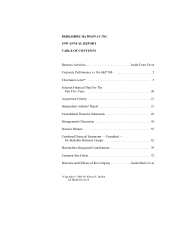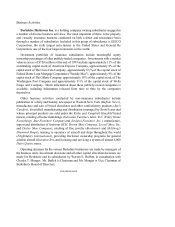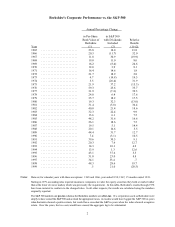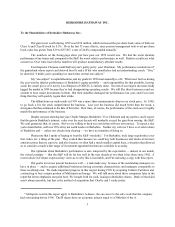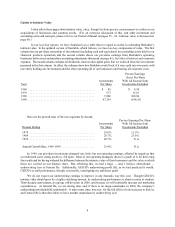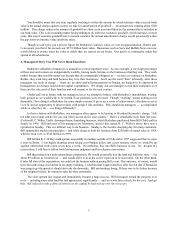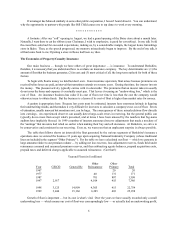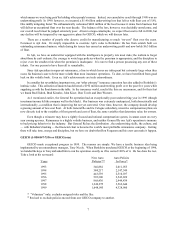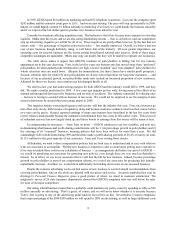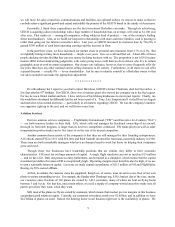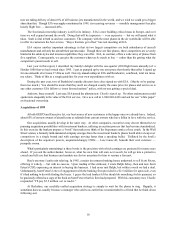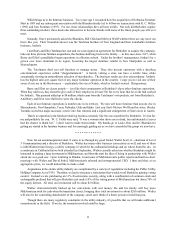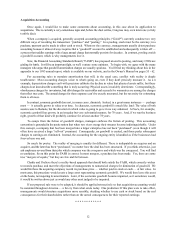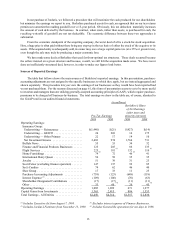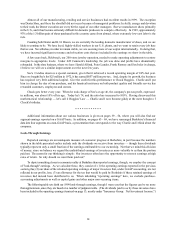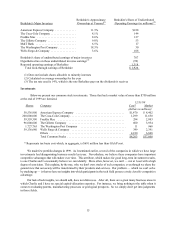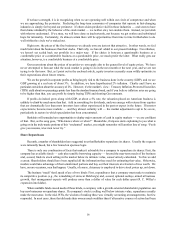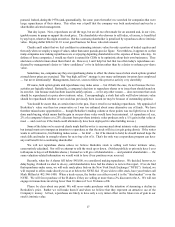Berkshire Hathaway 1999 Annual Report Download - page 8
Download and view the complete annual report
Please find page 8 of the 1999 Berkshire Hathaway annual report below. You can navigate through the pages in the report by either clicking on the pages listed below, or by using the keyword search tool below to find specific information within the annual report.
7
which means we were being paid for holding other people’s money. Indeed, our cumulative result through 1998 was an
underwriting profit. In 1999, however, we incurred a $1.4 billion underwriting loss that left us with float cost of 5.8%.
One mildly mitigating factor: We enthusiastically welcomed $400 million of the loss because it stems from business that
will deliver us exceptional float over the next decade. The balance of the loss, however, was decidedly unwelcome, and
our overall result must be judged extremely poor. Absent a mega-catastrophe, we expect float cost to fall in 2000, but
any decline will be tempered by our aggressive plans for GEICO, which we will discuss later.
There are a number of people who deserve credit for manufacturing so much “no-cost” float over the years.
Foremost is Ajit Jain. It’s simply impossible to overstate Ajit’s value to Berkshire: He has from scratch built a n
outstanding reinsurance business, which during his tenure has earned an underwriting profit and now holds $6.3 billion
of float.
In Ajit, we have an underwriter equipped with the intelligence to properly rate most risks; the realism to forget
about those he can’t evaluate; the courage to write huge policies when the premium is appropriate; and the discipline to
reject even the smallest risk when the premium is inadequate. It is rare to find a person possessing any one of these
talents. For one person to have them all is remarkable.
Since Ajit specializes in super-cat reinsurance, a line in which losses are infrequent but extremely large when they
occur, his business is sure to be far more volatile than most insurance operations. To date, we have benefitted from good
luck on this volatile book. Even so, Ajit’s achievements are truly extraordinary.
In a smaller but nevertheless important way, our “other primary” insurance operation has also added to Berkshire’s
intrinsic value. This collection of insurers has delivered a $192 million underwriting profit over the past five years while
supplying us with the float shown in the table. In the insurance world, results like this are uncommon, and for their feat
we thank Rod Eldred, Brad Kinstler, John Kizer, Don Towle and Don Wurster.
As I mentioned earlier, the General Re operation had an exceptionally poor underwriting year in 1999 (though
investment income left the company well in the black). Our business was extremely underpriced, both domestically and
internationally, a condition that is improving but not yet corrected. Over time, however, the company should develop
a growing amount of low-cost float. At both General Re and its Cologne subsidiary, incentive compensation plans are
now directly tied to the variables of float growth and cost of float, the same variables that determine value for owners.
Even though a reinsurer may have a tightly focused and rational compensation system, it cannot count on every
year coming up roses. Reinsurance is a highly volatile business, and neither General Re nor Ajit’s operation is immune
to bad pricing behavior in the industry. But General Re has the distribution , the underwriting skills, the culture, and
— with Berkshire’s backing — the fina ncial clout to become the world’s most profitable reinsurance company. Getting
there will take time, energy and discipline, but we have no doubt that Ron Ferguson and his crew can make it happen.
GEICO (1-800-847-7536 or GEICO.com)
GEICO made exceptional progress in 1999. The reasons are simple: We have a terrific business idea being
implemented by an extraordinary manager, Tony Nicely. When Berkshire purchased GEICO at the beginning of 1996,
we handed the keys to Tony and asked him to run the operation exactly as if he owned 100% of it. He has done the rest.
Take a look at his scorecard:
New Auto Auto Policies
Years Policies In-Force
(1)(2) (1)
1993 346,882 2,011,055
1994 384,217 2,147,549
1995 443,539 2,310,037
1996 592,300 2,543,699
1997 868,430 2,949,439
1998 1,249,875 3,562,644
1999 1,648,095 4,328,900
“Voluntary” only; excludes assigned risks and the like.
(1)
Revised to exclude policies moved from one GEICO company to another.
(2)

